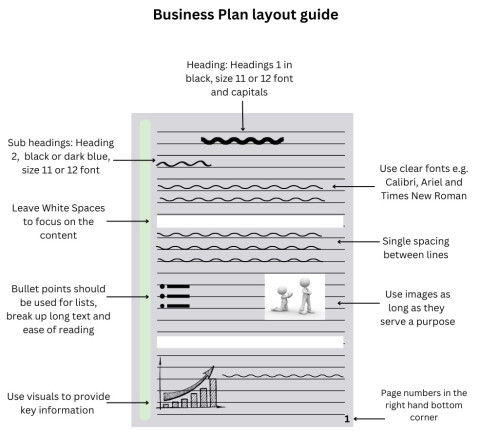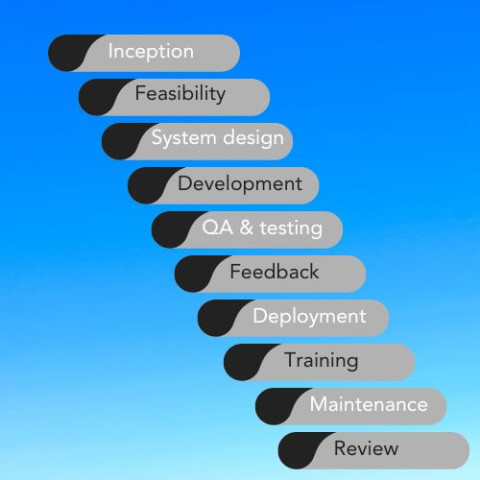Business Plans - Comprehensive Guide Part 3
Creating a Business Plan is a critical step for any entrepreneur aiming to establish a successful venture. This document provides a structured layout, encompassing various common sections that guide the development of the business. Key components include the Executive Summary, which offers a snapshot of the entire plan, and the business overview, detailing the company's mission, vision, and goals. By meticulously outlining these elements, a Business Plan not only sets a clear path for growth but also serves as a persuasive tool for attracting investors and stakeholders.
1. Writing a Business Plan
At all stages in the development of your Business Plan it is essential to keep it concise and to the point, remember, you are writing a summary of your Business and ideas, it is more likely to be read if it is a manageable length.
Presenting your plan professionally reflects you, your Business and the vision.
Be engaging, use a persuasive, positive tone and clearly define each section ensuring it reaches its objective.
a. Layout
10 Tips for a Business Plan layout:
- Include a cover or binding
- Avoid jargon and specific technical terms
- Write in the 3rd person, in clear language and layman’s terms
- Use headings and subheadings to break the plan into manageable chunks and create new sections
- Number the sections
- Ensure consistency throughout the document: Font type and sizes, line spacing, margins etc.
- Bold important text, but don't underline them. Italics are ok but use them sparingly
- Ensure colour visuals are still clear if printed in black and white
- Instead of trying to cram everything in using small fonts and tiny margins, focus on trimming down the text
- Make sure there are no spelling mistakes or grammatical errors

General TIPS:
- You may want to email it, so ensure you use email-friendly formatting and test it
- All facts are to be reasonable and credible, supported with sufficient documentation, quoting the source of research as a numbered footnote
- Be realistic, you are heading for major financial and reputation issues if you are over-optimistic.
- Ensure your proposal stands out, highlight your key/niche selling points.
- Detailed information, e.g. market research data, balance sheets, staff training etc., put in an appendix at the end
- Get at least two people to read it or use an expert adviser, e.g. your accountant, ask for feedback, make amendments where necessary but you must write the plan yourself, you know your Business more than anyone else
b. Common Business Plan sections
i. Cover page
Ensure you include in the Cover page:
- The Business name
- Names of the main contacts
- Full address details
- The client's company logo; and reader confidentiality (if applicable)
- Confidentiality Disclaimer
Where relevant, in plain English, add a confidentiality disclaimer to advise the reader that the content to follow is confidential.
‘This Business Plan has been prepared for review by John A. Smith. All information is confidential and should not be shared without written permission.
John A. Smith
____________ (signature)
Date
Get them to sign and date the title page under the disclaimer notice. This lessens any misunderstandings about the content and protects you and your Business.
ii. Personal details
Include:
Include:
- Name
- Contact number/s
- Email address
- Website or portfolio
- Any professional social media profiles you have
- What skills/qualifications you have
- What are you passionate about?
- What is/are your area(s) of industry expertise?
- If the business is a new start-up, what is your personal industry background, when did the business start and at what stage is the business?
iii. Contents page
Include a contents page, with page and section numbering.
Enable the quick jump to the sections in the document by linking them in the Contents.
iv. Executive Summary
The Executive Summary, also known as the Elevator Pitch, goes at the beginning and provides highlights, between 5%-10%, of the full Business Plan.
This slang term, ‘Elevator Pitch’, derives from the idea that when conveying a business summary, it should last no longer than the period of time of a short lift/elevator ride, approximately 30 to 60 seconds. In a written form it should be no more than 1,000 words and 2 pages.
The Executive Summary sets the tone for the rest of the Business Plan so ensure it has a positive and realistic tone.
Don’t include too many subsections as this can fragment it making it harder to read and lose the tone.
Frequently the Executive Summary is the last section to be written but as the first one to appear so it needs to be designed to capture the reader, enabling them to quickly get an understanding of the content of the document without having to read it all.
This summary may be the only opportunity you get to put your case to investors. Many lenders and investors make judgments about your Business based on this section of the plan alone.
Write the Executive Summary in the order of the Business Plan creating a flow to the document.
Executive Summary contents
- The first sentence or paragraph is key to gaining the attention of the reader
- Business description
- Market analysis
- Products or services
- Business Overview
- Financial information and projections
- Future plans
v. Business overview
State any relevant history of the business.
UK Legal Business Structures
Detail which current legal UK structure your Business is:
- Sole trader
- Partnership
- Limited liability Partnership
- Limited Company
Sole Trader
The basic and easiest form of business to register. You are a sole trader which is self-employed.
You must register with HMRC when you start working.
You keep all the profits but are still liable for tax and national insurance, via a Self Assessment Tax Return.
Partnership
A Partnership is where two or more people share the profits and losses in a business.
They share all business liabilities: costs, benefits, risks and responsibilities.
Other partners' negligence or misconduct are the responsibility of each partner.
Each partner pays their own tax on their share of the profits.
Limited Liability Partnership (LLP)
The partner’s liability relates only to the funds they invest in the business.
It can contain 2 or more members which can be individuals or a company.
Responsibilities and the share of profits are set out in the LLP agreement.
LLP must be registered with Companies House and annually prepare and file accounts.
All members have to register with HMRC, pay National Insurance and submit a personal Self-Assessment Tax return annually, and pay their share of the Partnership’s profits.
Limited Company
A Limited Company is a privately managed business whereby the shareholders own it and run it as Directors.
Being a separate legal entity, the business has its own obligations and legal rights, therefore the business is responsible for everything it does and the finances are separated from the personal finances of the owners.
The business must be registered with Companies House and annually prepare and file accounts and register with the HMRC.
Corporation Tax is to be paid and the profits left are kept by the business, which can then be shared between the shareholders, in the form of dividends.
Mission statement
A Company Mission Statement is a short summary, between 30-50 words, that captures what you do, how you do it, and who you do it for.
It serves as an internal and external communication method that should be concise, memorable, unique, realistic and current.
It defines the Company’s values, ethics, culture, values, ethics, agenda and fundamental goals.
Key elements:
- Purpose
- Strategy
- Policies and Standards
- Values
Legal requirements
Are there any legal requirements in starting the business?
- Health and Safety
- Food Hygiene and Safety
- Intellectual Property
- Online and Distance Selling
- Data Protection
Objectives
Goal setting for your business is the core of your Business Plan.
Revenue and customer forecasts should be SMART whether for the next 12 months or the next 5 years.

Print this SMART template

Think about the future of your Business, and what you would like to achieve over a set period of time. These can be broken down into short, medium and long-term goals.
A well-structured Business Plan is essential for guiding a business's development and securing investment. This document, with its clearly defined layout and common sections, provides a comprehensive roadmap for success. The Executive Summary offers a concise overview, while the business overview delves into the company's mission, vision, and goals. By thoroughly addressing these components, a Business Plan not only clarifies the strategic direction but also enhances credibility with potential investors and stakeholders. Ultimately, it is a vital tool for transforming a business idea into a thriving enterprise
To view the other articles in this series follow this link: https://bespokeuk.com/post-cat...

Mailchimp Alternatives Guide 2025
Is Mailchimp still the best FOR EMAIL MARKETING? Or are UK businesses find...
5 min read

The Hidden Cost of Poor System Integration
Why Poor Integration Between Systems Is Holding Your Business Back And How...
8 min read

Admin Overload: The Silent Business Killer
The cost of manual, repetitive admin tasks In countless small and medium-s...
3 min read


